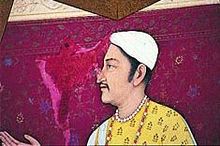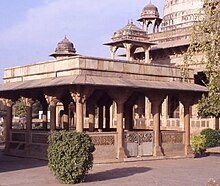Tansen
Tansen |
|---|
Tansen or Miyan Tansen or Ramtanu Pandey (1493 or 1506 – 1586 or 1589) is considered among the greatest composer-musicians in Hindustani classical music. He was an extraordinarily gifted vocalist, known for a large number of compositions, and also an instrumentalist who popularized and improved the rabab (of Central Asian origin).
He was one of the Navaratnas (nine jewels) at the court of the Mughal Emperor Akbar. Akbar gave him the title Miyan (an honorific, meaning learned man).
Early life
Tansen as a historical personality is difficult to extract from the extensive legend that surrounds him. It is reasonably certain that he was born into a Hindu Brahmin family, possibly in 1506, though some legends give it as 1493[1]; possibly in the village Behat near Gwalior. His father Makrand Ram Pandey was a poet and accomplished musician, who for some time was a temple priest in Varanasi. Tansen's name as a child was Ramtanu (he may have had other nicknames/names like Tanna and Mukul).
Born at a time when a number of Persian and Central Asian motifs were fusing with Indian classical music, his influence was central to creating the Hindustani classical ethos as we know it today. A number of descendants and disciples have also considerably enriched the tradition. Almost all gharanas of Hindustani classical music claim some connection with the Tansen lineage.
According to legend, he was noted for his imitations of animal calls and birdsong.
Career


At some point, he was discipled for some time to Swami Haridas, the legendary composer from Vrindavan and part of the stellar Gwalior court of Raja Mansingh Tomar (1486-1516 AD), specializing in the dhrupad style of singing. One legend has that Haridas was passing through the forests when the five-year old Ramtanu's imitation of a tiger impressed the musician saint. Another version is that his father sent him to Haridas. From Haridas, Tansen acquired not only his love for dhrupad but also his interest in compositions in the local language. This was the time when the Bhakti tradition was fomenting a shift from Sanskrit to the local idiom (Brajbhasa or Hindi), and Tansen's compositions also highlight this trend. At some point during his apprenticeship, Tansen's father died, and he returned home, where it is said he used to sing at a local Shiva temple.
In any event, Tansen went to Muhammad Ghaus who eventually became his spiritual mentor. He also married Husseini (lit. beautiful one),
"However, beyond a reference of Tansen's name in a list of his disciples Miyan Tansen's name is found among the names of the Mureeds (Fans) of the Shuttari Tariqat - a Sufi spiritual lineage founded by Shaykh Muhammad Ghaus of Gwalior."
The burial of Tansen in his shaykh's mausoleum is thought to indicate proof of his conversion to the path of his spiritual guide. Usually, the most prominent disciples of a saint are buried near the master's mausoleum, not much historical detail is known about their actual encounter.
The interaction with Ghaus in the Sufi tradition and the earlier training with Swami Haridas in the Bhakti tradition led to a fusion of these streams in the work of Tansen. As it is, the mystic streams of Sufism and Bhakti had considerable philosophical and stylistic overlap; Ghaus in his text Bahr-ul-Hayat (Ocean of Life) devotes several chapters to Yoga practices. In Tansen's music, we find he continues to compose in Brajbhasha invoking traditional motifs such as Krishna or Shiva.
Tansen was also influenced by other singers in the Gwalior court and also the musically proficient queen, Mriganayani, whose romance with the king had been forged on her singing; she remained a friend even after the death of the Raja. Other musicians at Gwalior may have included Baiju Bawra.
Eventually, he joined the court of King Ramachandra Baghela of Rewa, India, where he remained from 1555-1562[2]. It appears that the Mughal emperor Akbar heard of his prowess and sent his emissary Jalaluddin Qurchi to Ramachandra, who had little choice but to acquiesce, and Tansen went to Akbar's court in 1562.
Another legend is that Akbar's daughter Meherunnissa was enamoured by Tansen and had a role in his coming to Akbar's court[1].
Tansen joined Akbar's court eventually becoming one of the treasured Navaratnas (lit. nava=nine, ratna=jewel) of his court. It was Akbar who gave him the honorific title Miyan, and he is usually referred to today as Miyan Tansen. Legend has it that in his first performance, he was gifted one lakh (100,000) gold coins.
The presence of musicians like Tansen in Akbar's court has been related by historians to the theoretical position of making the empire's audible presence felt among the population, a mechanism related to Naubat or ritual performance[3].

The fort at Fatehpur Sikri is strongly associated with Tansen's tenure at Akbar's court. Near the emperor's chambers, a pond was built with a small island in the middle, where musical performances were given. Today, this tank, called Anup Talao, can be seen near the public audience hall Diwan-i-Aam - a central platform reachable via four footbridges. It is said that Tansen would perform different ragas at different times of day, and the emperor and his select audience would honour him with coins.
Tansen's alleged residence is also nearby.
Family
Tanras Khan, Bilas Khan, Hamirsen, Suratsen and Saraswati Devi, all musicians. Bilas Khan is said to have created raga Bilaskhani Todi after Tansen's death; an interesting legend of this improvisation (it differs only in detail from Tansen's Todi), has it that Bilas composed it while grief-stricken at the wake itself, and that Tansen's corpse moved one hand in approval of the new melody.
Tansen's blood descendants – the Senia gharana - held considerable prestige in musical circles for several centuries. The royal courts of Rewa, India, Rampur and Jaipur among others, retained many noted members of Tansen lineage, including Nayak Wazir Khan (guru of Allauddin Khan) and Mohammed Ali Khan. Wazir Khan, who is of Saraswati Devi lineage, was also a musicologist who wrote the Risala Mousibi. One of the last of the line, Dr Dabir Khan, (1905-1972, Saraswati Devi lineage) was a dhrupadiya and a beenkar, at Radio Calcutta.
Musical legacy
The legendary musical prowess of Tansen surpasses all other legends in Indian music. In terms of influence, he can be compared only to the prolific sufi composer Amir Khusro (1253-1325), or to bhakti tradition composers such as Kabir or Haridas.
Several of his raga compositions have become mainstays of the Hindustani tradition, and these are often prefaced with Miyan ki ("of the Miyan"), e.g. Miyan ki Todi, Miyan ki Malhar, Miyan ki Mand, Miyan ka Sarang; in addition he is the creator of major ragas like Darbari Kanada (lit. Darbari= of the court, Kanada=Carnatic), Darbari Todi, and Rageshwari.
Tansen also authored Sangeeta Sara and Rajmala which constitute important documents on music.
Almost every gharana (school) tries to trace its origin to him, though some try to go further back to Amir Khusro[4]. As for the Dhrupad style of singing, this was formalized essentially through the practice by composers like Tansen and Haridas, as well as others like Baiju Bawra who may have been a contemporary.
After Tansen, some of the ideas from the rabab were fused with the traditional Indian stringed instrument, veena; one of the results of this fusion is the instrument sarod, which does not have frets and is popular today because of its perceived closeness to the vocal style.
The famous qawwals, The Sabri Brothers claim lineage from Miyan Tansen [5]
Legends
The bulk of Tansen's biography as it is handed down in the musical literature constitutes of legends[6].
Among the legends about Tansen are stories of his bringing down the rains with Raga Megh Malhar and starting fires with the legendary raga Deepak [7]. Other legends tell of his ability to bring wild animals to listen with attention (or to talk their language). Once, a wild white elephant was captured, but it was fierce and could not be tamed. Finally, Tansen sang to the elephant who calmed down and the emperor was able to ride him.
Many aficionados are convinced that his death was caused by a conflagration while he was singing the raga Deepak.

Death
According to one version of the story, Tansen died on 1586-04-26, and that Akbar and much of his court attended the funeral procession[1]. Other versions give 1589 as the year of his death. Tansen was buried in the mausoleum complex of his Sufi guru Shaykh Muhammad Ghaus in Gwalior.
Every year in December, an annual festival, the Tansen Samaroh, is held in Gwalior to celebrate Tansen[8].
References
- ^ a b c
Maryam Juzer Kherulla (2002-10-12). "Profile: Tansen — the mesmerizing maestro". Dawn (newspaper). Retrieved 2007-10-02.
{{cite news}}: Check date values in:|date=(help) - ^
S K Banerjee (2003). "The classical music tradition of Rewa (M.P.) in the 19th and 20th century A.D". Journal of the ITC-SRA. 17, .
{{cite journal}}: CS1 maint: extra punctuation (link) - ^ Wade, Bonnie C. (1998). Imaging Sound : An Ethnomusicological Study of Music, Art, and Culture in Mughal India. University of Chicago Press. ISBN 0-226-86840-0.
- ^ The Dagar family of dhrupad singers believe themselves to be the direct descendants of not Tansen but his guru, Haridas Swami.
- ^ Template:Url=http://www.musicweb.uk.net/encyclopaedia/s/S2.HTM
- ^ Ashok Davar (1987). Tansen - The Magical Musician. National Book Trust, India.This is well-written and well-illustrated children's book is a good source for the Tansen legend
- ^ Raga Megh Malhar is still in the mainstream repertoire, but raga Deepak is no longer known; three different variants exist in the Bilawal, Poorvi and Khamaj thaats. It is not clear which, if any, corresponds to the Deepak of Tansen's time. There is a popular myth that it disappeared because it could indeed bring fire, and so was simply too dangerous to sing.
- ^ "Strains of a raga ... in Gwalior". The Hindu. 2004-01-11.
{{cite news}}: Check date values in:|date=(help) report on the annual Tansen's Samaroh in Gwalior. Also has picture of his mausoleum
